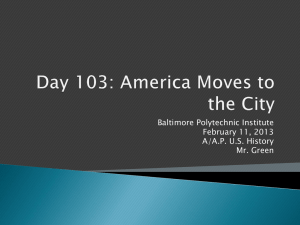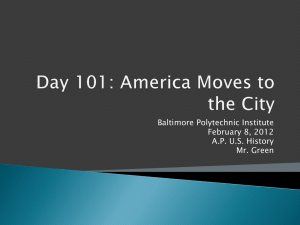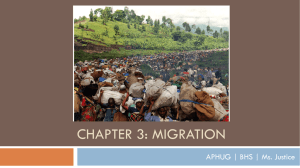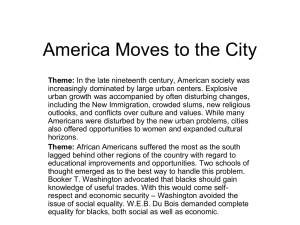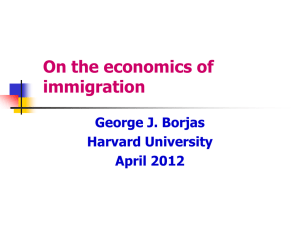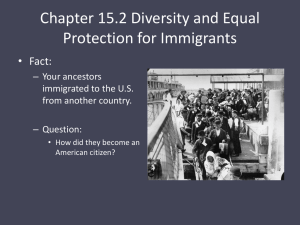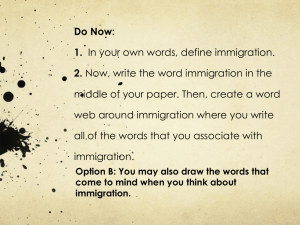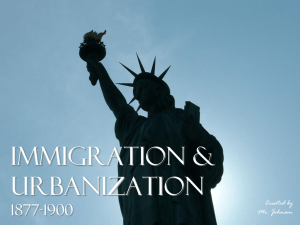Course
advertisement
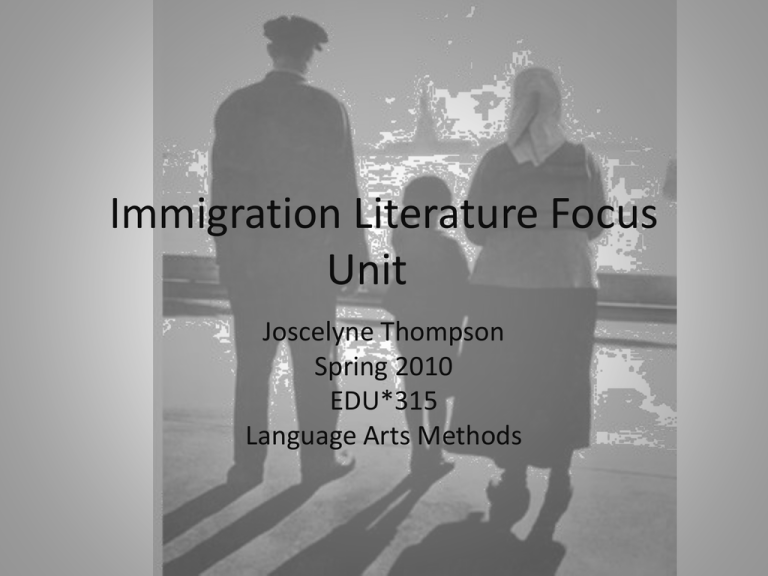
Immigration Literature Focus Unit Joscelyne Thompson Spring 2010 EDU*315 Language Arts Methods The story of immigration is inseparable from this country's history. Discover the United States all over again as you introduce your students to the two major waves of immigration that brought 34 million people to our nation's shores and spurred the greatest period of national change and growth. All Americans, with the exception of Native American, are descended from immigrants. The greatest number of immigrants -- more than 34 million -- arrived in the United States during the 100 years preceding 1924, when new legislation closed the country's relatively wide-open door. The first major wave of immigration after 1824 consisted primarily of northern Europeans from Ireland, Great Britain, Germany, and Scandinavia. The second wave of immigrants -- mainly from southern and eastern Europe -- arrived between 1890 and 1924. The story of those years and those immigrants is also the story of our country's growth. http://www.educationworld.com/a_lesson/lesson204.shtml America was built by immigrants. From Plymouth Rock in the seventeenth century to Ellis Island in the twentieth, people born elsewhere came to America. Some were fleeing religious persecution and political turmoil. Most, however, came for economic reasons and were part of extensive migratory systems that responded to changing demands in labor markets. Their experience in the United States was as diverse as their backgrounds and aspirations. Some became farmers and others toiled in factories. Some settled permanently and others returned to their homeland. Collectively, however, they contributed to the building of a nation by providing a constant source of inexpensive labor, by settling rural regions and industrial cities, and by bringing their unique forms of political and cultural expression. http://www.history.com/topics/immigration Literature Selection • The House on Mango Street by, Sandra Cisneros; 5th grade level – • Hannah's Journal: The Story of an Immigrant Girl by Marissa Moss – • • • • General Coming to America: The Story of Immigration by, Betsy Maestro Dreaming of America: An Ellis Island Story by, Eve Bunting; 3rd-5th – • Russian If Your Name Was Changed at Ellis Island by, Ellen Levine; 1st-4th – • Russia Where Did Your Family Come from? by Melvin and Gilda Berger The Keeping Quilt by, Patricia Polacco; 3rd-5th – • Russia The Night Journey by Kathryn Lasky; 4th+ – • Lithuania Land of Hope by Joan Lowery Nixon – • Latino Ireland Was Dreaming to Come to America: Memories from the Ellis Island Oral History Project by, Veronica Lawlor Letters from Rifka by Karen Hesse • • • Immigrant Kids by, Russell Freedman; 3rd-5th The Memory Coat by, Elvira Woodruff; 2nd-5th My Diary from Here to There/Mi diario de aqui hasta alla by, Amada Irma Perez • My Chinatown: One Year in Poems by, Kam Mak – – • Hong Kong Tha Name Jar by, Yangsook Choi – • Mexico Korea Coming to America: A Muslim Family’s Story by, Bernard Wolf – Egypt • A Picnic in October by, Eve Bunting • Dia's Story Cloth by Dia Cha • A Step from Heaven by An Na – – – • Hmong Korean Home of the Brave by Katherine Applegate – • • • • Italy Somali A Very Important Day by Maggie Rugg Herold The Orphan of Ellis Island by Elvira Woodruff Journey to Ellis Island by Carol Bierman Land of Dreams (Ellis Island Stories) by Joan Nixon Lowery Quotes regarding immigration • • • • "Everywhere immigrants have enriched and strengthened the fabric of American life. " -- John F. Kennedy "Unless the stream of these people can be turned away from their country to other countries, they will soon outnumber us so that we will not be able to save our language or our government." -- Benjamin Franklin "Give me your tired, your poor, Your huddled masses yearning to breathe free, The wretched refuse of your teeming shore. Send these, the homeless, tempest-tost to me, I lift my lamp beside the golden door!" -- Emma Lazarus (inscribed on the Statue of Liberty) ...except for "all idiots, imbeciles, feeble-minded persons, epileptics, insane persons; persons who have had one or more attacks of insanity at any time previously; persons of constitutional psychopathic inferiority; persons with chronic alcoholism; paupers; professional beggars; vagrants; persons afflicted with tuberculosis in any form or with a loathsome or dangerous contagious disease; persons not comprehended within any of the foregoing excluded classes who are found to be and are certified by the examining surgeon as being mentally or physically defective, such physical defect being of a nature which may affect the ability of such alien to earn a living; persons who have been convicted of or admit having committed a felony or other crime or misdemeanor involving moral turpitude; polygamists, or persons who practice polygamy or believe in or advocate the practice of polygamy; anarchists, or persons who believe in or advocate the overthrow by force or violence of the Government of the United States." -- The Immigration Act of 1917 Quotes (cont) • • “Then one bright morning, a cry went up from the front of the ship. It was just one word: “L’America!” The word traveled through the crowd like something alive. It was whispered. It was shouted. It was almost like a prayer. “Come!” Marco called to the family from the railing. Everyone on the ship was rushing to the right side of the boat. But the children slithered through the crowd to join their uncle. “Look! It’s beautiful!” …The harbor, full of big ships and small boats, sparkled in the sunlight. There were green, bountiful farms n both sides of the Hudson River. And there, almost close enough to touch, was the most wonderful thing of all: the Statue of Liberty. …She looked serenely over the water, as if to say, “It’s all right. I’ll protect you now.” Her crown shone in the sun, and her torch climbed to the sky. A hush fell over the crowd on the ship. Many people cried, even grown men. -Hitty’s Travels: Ellis Island Days, by Ellen Weiss” There were probably as many reasons for coming to America as there were people who came. It was a highly individual decision. Yet it can be said that three large forces—religious persecution, political oppression and economic hardship—provided the chief motives for the mass migration to our shores. They were responding, in their own way, to the pledge of the Declaration of Independence: the promise of "life, liberty and the pursuit of happiness." —John F. Kennedy, A Nation of Immigrants, 1964 Focus Books Focus Book • The House on Mango Street – By, Sandra Cisneros Read Aloud • Hannah's Journal: The Story of an Immigrant Girl – By, Marissa Moss Poems to incorporate The New Colossus By, Emma Lazarus (found at the base of the Statue of Liberty) Let America Be America Again By, Langston Hughes When We Left El Salvador. By, René Colato Laínez Wonders of the City By, René Colato Laínez Farewell to the Farm by Robert Louis Stevenson Immigration Bugaloo by DeAnne Wiley Theme Study • Students will take part in a thematic unit about immigration. This unit will integrate reading and language arts with social studies, mathematics, art, music, and physical education. • Students will gain understanding of the reasons people immigrated to America, how they immigrated, how immigration affected America, and tolerance of people. Unit goals • Students will be able to identify reasons why many immigrants left their homelands to come to America. • Students will be able to draw conclusions about the immigrant experience and to identify local immigration patterns. • Students will come to a deeper understanding of the immigrant experience. • Students will discuss present day immigration issues and pose solutions for the issues. • Students will be more tolerant of the people around them that may appear as different than them. How to introduce the unit • Break the class into groups of 4. Each group is then given the same craft-like materials: ex. glue sticks, popsicle sticks, plastic cups, index cards, staplers, tape, string, construction paper, foil, stickers, etc. Really, anything could be used as long as each group has the same size, shape, color, and number of objects. The task:Each group is given about 20 min. to create a "creature". They may use any of the materials provided. The catch is, they are absolutely forbidden to speak to one another in words or writing. Gestures and facial expressions are okay, but no other communication. • When time's up, each group is given time to display their version of a "creature" and explain the pros and cons of working in a group that couldn't communicate in words or written responses. http://www.proteacher.org/a/134129_ideas_for_immigration.html Language Arts: Reading Activities • Students will read various books about immigration, fiction and non-fiction, as well as poetry through partner reading, small group reading, silent reading, group reading, reading aloud, and reader’s theater. • Students will read poetry they create about immigration and America. • Students will share their journals with their peers. • Students will share their pen pal letters with their peers. • Teacher will read aloud from Hannah's Journal: The Story of an Immigrant Girl by Marissa Moss, The Night Journey by Kathryn Lasky, as well as other books about immigrants. Language Arts: Writing Activities • • • • • • • Students write a letter to an imaginary “pen pal.” The students should include details about what life is like in America because this letter is to be created for a child who would be immigrating to America and be nervous about the move. Students will write and illustrate what they would take with them if they had to immigrate to another country and limit either the number of items or the amount of space they can take up. Students will create a journal from the perspective of an immigrant child. The journal needs to include: What country they are leaving; why they are leaving their homeland; who they are travelling with on their journey; who they left behind; what they brought with them; what they think their life will be like in America. Students will create a free verse poem either about immigration or about America. Students will research information about immigration in which they will complete a written report about what they learn. Students will create and present a Reader's Theater based on The Keeping Quilt by Patricia Polacco. Students will create a journal entry about why it is important to understand other people’s cultural heritage. Language Arts: Speaking Activities • The House on Mango Street Reader's Theater • Presentations regarding family history and group research project regarding immigration • Grand conversations about immigration • The students will use the author’s chair to present their poems and stories. • Students will participate in a small group discussion about The House on Mango Street by Sandra Cisneros • Students will take part in peer conferences for their letters, poems, and stories. Language Arts: Listening Activities • Students will listen to audio versions of immigration literature. • Students will listen as the teacher discusses immigration and how/why it occurs. They will listen as the teacher shares information about how immigration has affected North Dakota. • Students will listen respectfully to their peers as they share their narrative story regarding what they would bring if they had to immigrate to another place, poems, journal entries, and personal history. • Students will listen to their peers opinions during grand conversations. • Students will listen to music and videos about immigration. • Students will listen respectfully to guests that come into the classroom to discuss immigration through their personal experiences as a child and/or adult. Language Arts: Viewing Activities • Students will view pictures of people who have immigrated as well as the Statue of Liberty. • Students will view movies about the Statue of Liberty and immigration (see technology ideas). • Students will view illustrations what they would bring as well as collages of the Statue of Liberty created by their peers. • Students will view the Reader’s Theater performances • Students will view the immigration word wall • Students will view various websites regarding immigration (see technology ideas). Language Arts: Visually Representing Activities • Students will create illustrations of the process of immigration and what they would bring with them. • Students will create a collage of magazine cutouts that represent America in the shape of the Statue of Liberty. • Students will display their poems in an artistic presentation. • Students will create an Immigration Word Wall. Science Activities • Students will investigate how immigration affected the land through discussion and research. • Students will research the weather patterns and climates of countries in which it was common for people to immigrate to North Dakota from, such as Germany, Russia, Norway, Yugoslavia, England, and Sweden. Students will then create a hypothesis as to why many people chose North Dakota. Mathematics • • • • Students will research information regarding the number of immigrants that entered the country between 1899-1924 (other students could be given other ranges of years so as to create a comparison). Students will then create graphs based on the information that they have found. Also, there is a related activity that is found on http://www.educationworld.com/a_lesson/TM/l204_immigmath.shtml in which the students are given a worksheet with questions that must be answered based on a chart they are given. They then must create a graph out of five countries of interest. Students bring in family recipes that have been passed down through the generations. Adding fractions and forms of measurement using the amounts given in the recipes are the major concepts covered. Students will then convert their recipe so that it could serve 50 people, 100 people, and 500 people. Students then bring in the actual foods made from the recipes at the end of the unit as a "Family Reunion". Graphing can be used in many areas of this unit. Countries, dates of entry, and family members that immigrated can all be graphed as well as many others. They can then create a presentation on the information gathered. Students use spreadsheets to create graphs and PowerPoint to present their findings. Social Studies • Read the book Where Did Your Family Come from? by Melvin and Gilda Berger • Create a chart with the following categories to discuss with students: – – – – – Name and country they came from Why they came to America How they came to America Hardships/problems they faced coming to America Things they learned to do/overcome • Students pick a character to write a journal entry as. (Language Arts) • Students will research their family history and where their relatives have come from. They will need to report on where they came from, what reasons their family came (if known), how they came to America, and any other information they find important. Students will then create a presentation and report regarding what they have learned. – A large world map will be hung in the classroom. Each student will be given at least one piece of string to which they will attach it to where their family came from and where they came to in America. Social Studies (cont) • Set up an immigration simulation in the room to be somewhat like Ellis Island. Each student is given a role like: eye exam doctor, general doctor, hospital building nurse, security officer, ticket master, interrogator (Asks questions such as how much money do you have? Where will you live? Are you planning on overthrowing the gov't? Do you already have a job lined up? Can you read/write, etc.), immigrants from various countries, and interpreters who speak one or more languages. Each student is given a card that explains his/her role and their particular situation. For instance: *An immigrant may have to walk with a limp while walking up the main staircase. The examiner at the top of the stairs will consider the person lame, and not permit him/her into the country. Instead, he/she will have to go the hospital building until it is decided if he/she can remain in the country or be sent back. *A doctor may be given a card that says he/she must only allow three immigrants to pass. Each immigrant will have a black piece of construction paper pinned to his/her back. The doctors will mark with chalk a code that indicates if the immigrant has any ailments such as back trouble, eye problems, mental illness, etc. *An immigrant may have a card that says he/she cannot find any interpreters who speak his/her language. Therefore, that immigrant is to get very, very angry. Security has to be called, and the person is considered to have a mental illness. Of course, this gets the immigrant sent home. At the end the kids will reflect on their feelings during the experience. Some may be disappointed they were by not being permitted into the country; others will say how frustrating it was that they couldn't find anyone who spoke their language; others will end up saying how happy they were to make it through the whole process. http://www.proteacher.org/a/134129_ideas_for_immigration.html Social Studies (cont) • • Discuss the importance and history of the Statue of Liberty. First, discuss the history of the Statue of Liberty. (To begin, it was given by the people of France to the people of the United States over one hundred years ago in recognition of the friendship established during the American Revolution, there is much more detail in which the students would learn. A great website for all this information is http://www.statueofliberty.org/Statue_History.html ) Then, have a large picture of the Statue of Liberty available for the students to view. They would then brainstorm and discuss if there is possibly symbolism in how the statue was designed and built and then point at different parts to see if the students can determine the reason. Some of the symbolisms of the Statue of Liberty: – – – – – – – The torch- enlightening the way to freedom The robe- law and order 25 windows in her hat- the number of seas and continents in the world Tablet that she holds- American declaring its independence from Britain Broken shackles on her feet- freedom from tyranny Upraised right foot- leading the way to freedom Rays on hat- heaven’s rays shining down on the world Music and Art Activities • Students will create illustrations of what they would bring with if they had to immigrate to another country. • Students will prepare an artistic presentation of their poetry. • Students will create a collage of America by cutting the shape of the Statue of Liberty and then using magazine cut outs to create the look of the statue. They will also create a background for their Statue of Liberty collage. • Students will listen and learn the lyrics to various songs about immigration (see songs to incorporate). • Students will create new lyrics to a traditional song about America, such as “America the Beautiful.” Songs to Incorporate • • • • “America” by Neil Diamond “America” by Simon & Garfunkel “Wavin' Flag” by K'naan Multiple Artists: – “This Land is Your Land” – “Star Spangled Banner” – “America the Beautiful” • “Immigration Island” by Tim Sparling and Allen Werneken • “Lady off the Shore” by Michael Rychlik and Andy Davis • “Playing for Change” videos and songs as they show people around the world singing different songs about peace Physical Education Activities (see following slide for directions) • Students will learn multi cultural games such as: – – – – 1,2,3 Dragon (China) Kameshi Ne Mpuku (Congo) King or Queen of the Jewels (Europe) Soccer (much more popular in other areas of the world) • Students will learn popular dances from other areas of the world, such as: – – – – – The Reel (Scotland/England/Ireland) Tinikling (Asian countries) Chinese Ribbon Dance (China) d'hammerschmiedsgselin (Germany) There are many other dances that are culturally specific, such as different styles of dances performed in the Hawiian Islands, the Hora in Israel, and even some that were truly developed in America. The video http://www.youtube.com/watch?v=Hd60_VA88-M gives several examples of different dances while also showing how they are done. • Directions for Physical Educations Activities 1,2,3 Dragon (China) – – – – – – • Kameshi Ne Mpuku (Congo) – – – – – – – – • Students form a line and hold onto the shoulders or waist of the person in front of them. The person at the front of the line is the head, and the person at the back of the line is the tail. The teacher instructs the group to start jogging. When the head calls, “1, 2, 3 Dragon!” the head begins to chase the tail to try and tag it. If the tail gets tagged, the head goes to end of the line and becomes the tail. A new player becomes the head. If the line breaks, the dragon “dies” and a new head must be chosen. Players are chosen to be the cat and the rat. The remainder of the class will be placed into four rows, holding hands, and standing parallel to each other. The object of the game is for the cat to tag the rat. The rat tries to avoid the cat. The other children act as the barriers for the cat and the rat to run between. The catch is that the teacher or the cat can call “mpuke ekali” which means “let the rat stop.&rdqup; This call signals the children to drop hands with the people in their lines. All students turn a quarter turn to the left, so that they are all in new lines now (the lines just changed from horizontal to vertical). Students should quickly hold hands with the new people next to them. Now that the line direction has changed, the rat may be easier or harder to catch. The game ends when the rat is caught or the teacher calls time. The cats and rats should then change places with two students in the lines. King or Queen of the Jewels (Europe) – – – – – – – Set up four hula hoops (or make four circles with chalk) in each corner of the activity area. Put one bean bag (or whatever you choose to use) in the center of the hoop. This is the jewel. Choose one student to be either the king or queen of each of the hula hoops. Their job is to protect or guard the “jewel” inside the hoop. The king or queen guards the jewel by standing outside of the hoop. The rest of the students are thieves. They move around the hoops and try to steal the jewels. The king or queen should tag any thief who tries to steal from them. If a thief is tagged before he or she steps inside of the hoop, they are out. You can also choose to just have the player continue. If a thief makes it safely into the hoop without being tagged, they are the new king or queen. They will trade places and jobs with the old king or queen. Depending on the number of students playing, you may need to add or subtract the number of kings and queens. Websites for dance instructions • • • • The Irish Reel is very similar to the popular “Riverdance.” On YouTube, there are some examples such as on http://www.youtube.com/watch?v=e58jAqXq8PY, also the website http://www.learntodance.com/online%20irish%20dancing%20lesson.htm gives some instructions on performing this dance. There are many videos on YouTube if you simply search “Tinikling.” However, http://learn.sdstate.edu/melissa_mork/sctinikling.htm is a wonderful site that gives great descriptions and teaches how to perform this dance. Again, YouTube has several examples of Chinese Ribbon Dancing such as the link http://www.youtube.com/watch?v=n-GADdbtCb8, also the website, http://www.ehow.com/how_2125423_perform-ribbondance.html?ref=Track2&utm_source=ask, offers instruction for performing the ribbon dance. In regards to the d'hammerschmiedsgselin, the website, http://learn.sdstate.edu/melissa_mork/German.html, gives instruction while both http://www.youtube.com/watch?v=9k6elrj2NZQ and http://www.youtube.com/watch?v=kuyqF_VZYOs show videos of people doing the dance. Technology for Student Use • • • • • • • • • • • • • http://www.npg.org/facts/us_imm_decade.htm http://www.urban.org/Publications/305184.html (might be a little tough for some students) http://www.history.com/topics/about-ellis-island http://www.ellisisland.org/photoalbums/ellis_island_then.asp http://students.umf.maine.edu/yestrajm/public.www/Immigration%20Website/w hatisimmigration.html http://teacher.scholastic.com/activities/immigration/tour/index.htm http://www.ohranger.com/ellis-island/destined-fame http://web.archive.org/web/20070406212547/http://www.ailf.org/notable/famou s.htm http://immigrationupdate.wordpress.com/famous-american-immigrants/ http://history.wisc.edu/archdeacon/404tja/batv3.html http://www.endex.com/gf/buildings/liberty/liberty.html http://www.thirteen.org/tenement/index.html http://www.nps.gov/stli/photosmultimedia/virtualtour.htm Language Arts Strategies • Activating background knowledge: students will think about what they already know about immigration • Brainstorming: students will think of many ideas related to immigration through writing and group discussion activities • Connecting: students will relate to the world around them by journaling, interviewing, and researching about immigration • Predicting and Monitoring: students will predict the reasons why people immigrated to America and monitor their predictions as they research and gain knowledge • Playing with language: students will use language creatively through stories, poems, and journals • Revising: students will make changes to their written activities • Visualizing: students will draw pictures in their minds as different stories are read and their knowledge base grows Language Arts Skills • Print: students will recognize words on their Immigration Word Wall • Comprehension: students will recognize literary genres of fiction, non-fiction, and poetry. Students will compare and contrast immigration patterns and common reasons for immigration. • Language: students will apply various skills in their writing activities: stories, poems, song lyrics, and journal entries. • References: students will create graphs, Venn diagrams, and research immigration Grouping Patterns • Large group: grand conversations, interviews, field trips (if a multicultural center is in the area), physical education activities, viewing videos, singing songs, word wall, Reader’s Theater, Venn diagram, predictions, listening to presentations • Small group: peer conferences, small group discussions, creating song lyrics, creating a Reader’s Theater, researching immigration, researching countries that were commonly immigrated from to this area, math research and graphing • Individual: writing stories, poems, letters, journal entries, researching family history, creating illustrations and art work End of Unit Celebration • Students will get to celebrate the end of the unit with a popcorn party and a MultiCultural Family Night! • The film An American Tail (1986) will be shown during the popcorn party to wrap up the unit. • Also, the class will hold a Multicultural Family Night to celebrate what the students have learned and share the information with their families. – During this time, traditional foods will be brought in by the students to share. – Any local dance groups can be brought in to perform their style, such as square dancers, polka dancers, etc. – This will also be a time in which the students will be able to share their writings, art, and presentations with their families. Monday Morning Tuesday Wednesday Thursday Friday Grand conversation Listening center and •Writer's Workshop: •Writer's Workshop: •Create lyrics for a silent reading: Write a poem about Immigration story song about America •Read aloud: Hannah's Journal immigration stories immigration or peer confrences •Author's chair: share immigration stories •Teacher provides •Writer's workshop: America •Reader's Theater: write a story~ What I •Students will write The House on Mango Language Arts information on immigration Would Take with Me letters to a pen pal Street •Partner reading of •View videos •Guided reading: immigration The Keeping Quilt literature •View photographs of •Listen to songs •View photos of •Create Statue of •Artists gallery: view people from other about immigration Ennis Island Liberty collage poem, collages, and areas of the world and the Statue of illustrations •Create an artistic Liberty background for poem •Perform Art/Music immigration songs and sing new lyrics Physical Education Math Science Afternoon Social Studies Play 1,2,3 Dragon Play Kameshi Ne Mpuku Graphing worksheet Reseach and graph immigration information from other countries Students will research how immigration affected land •Read Where Did Your Family Come From •Create a brainstorming chart about immigration Play King or Queen Learn folk dances of the Jewels Research number of immigrants between 1899-1924 and create a graph Students will Students will research how research weather immigration affected patterns of other land countries •Teacher discusses •Discuss the what it was like to go importance, history, through Ennis Island and symbolism of •Students take part in the Statue of Liberty simulation •Students will begin working on their Students bring in family recipes and convert for larger groups Continue folk dances Begin watching An American Tail Students will present what they have found Watch An American regarding weather Tail and land •Students will present •Finish watching An their family history American Tail projects to the class •Finish family history presentations Assessments • Journal entries and KWL chart • Participation in grand conversations • Analytical Writing Traits Rubrics and peer conferences for stories and poems • Informal observation of author’s chair, Reader’s Theater, small group involvement • Math graphs, Social Studies activities • Spelling test using the Word Wall • Active participation in music and physical education activities • Portfolio of completed art work • Completion of work assigned • Portfolio of projects and the rubrics that are specific to each project.


